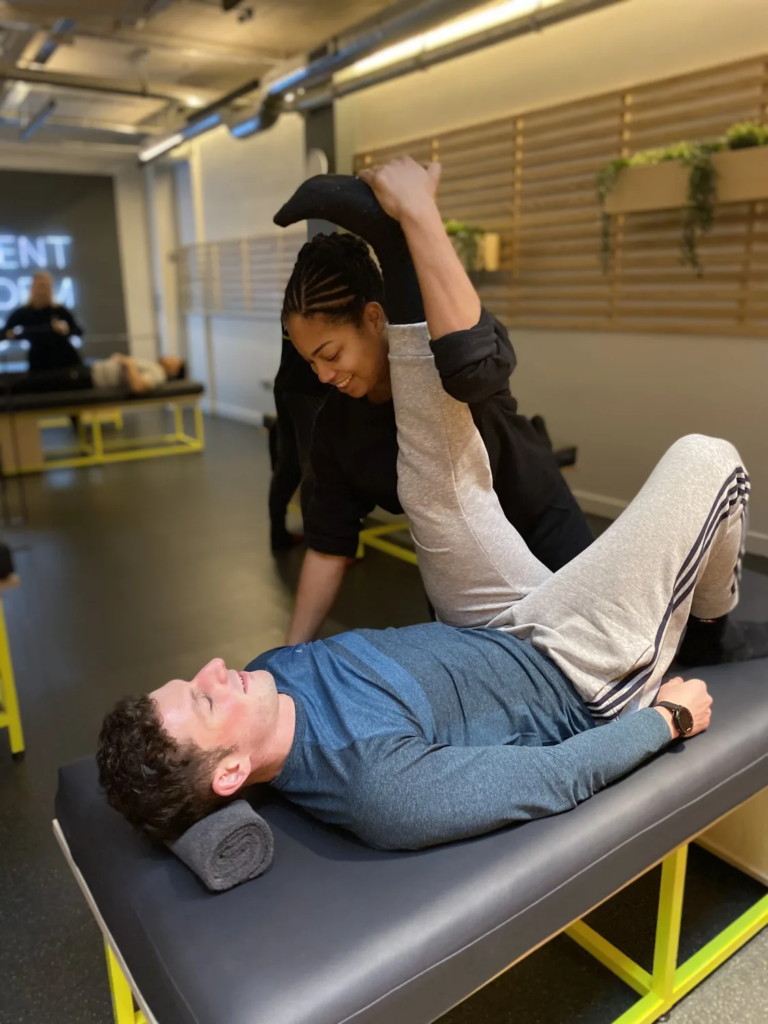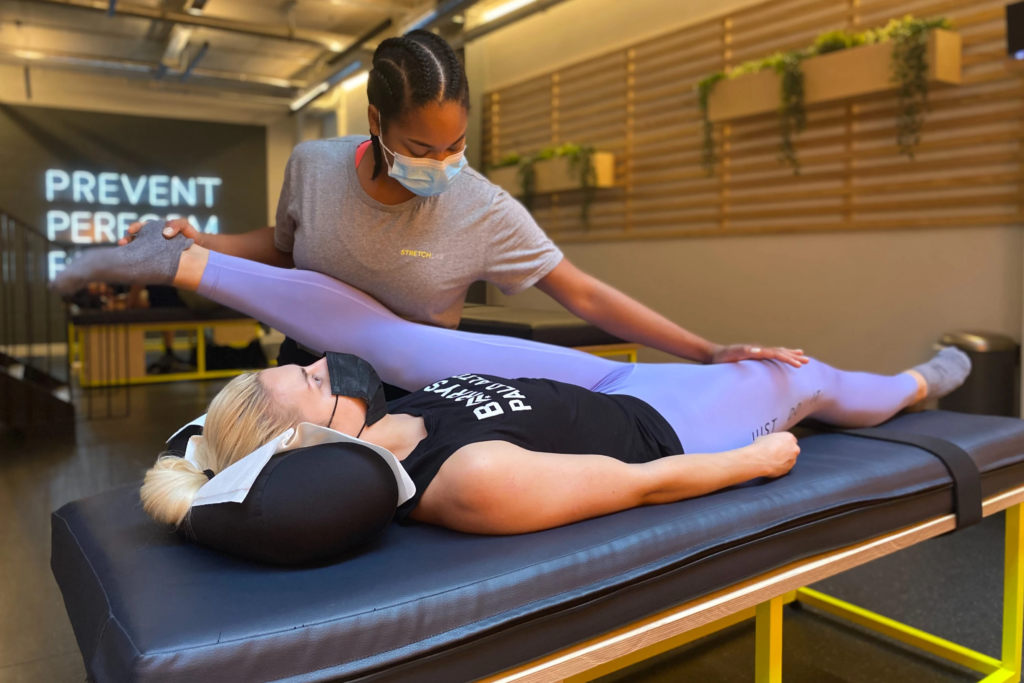
Stretching is an essential part of fitness and overall wellness, helping to improve flexibility, prevent injury, and reduce muscle tightness. Stretch Lab, a popular chain offering personalized assisted stretching services, has gained attention for its hands-on approach to flexibility and mobility. On the other hand, at-home stretching remains a simple and accessible method that many people rely on. Both options come with their own advantages and disadvantages. This article compares Stretch Lab and at-home stretching, providing insights into their pros and cons so you can decide which method best suits your needs.
Stretch Lab: Pros and Cons
Pros of Stretch Lab
1. Expert Guidance
One of the major advantages of Stretch Lab is access to trained Flexologists, who guide you through each session. These professionals have a deep understanding of human anatomy and stretching techniques, allowing them to safely and effectively increase your flexibility while minimizing the risk of injury. The personalized nature of assisted stretching ensures that each session is tailored to your body’s needs.
- Benefit: For those who lack knowledge or experience with proper stretching techniques, expert guidance is invaluable. The Flexologist can also address problem areas, such as tight hips, hamstrings, or back muscles, with targeted stretches.
2. Deeper Stretches
Assisted stretching at Stretch Lab allows for deeper, more effective stretches than what most people can achieve on their own. By having a professional move your body through its range of motion, you can go beyond your natural limits without strain or discomfort. This is especially beneficial for athletes, people with limited mobility, or those looking to significantly improve flexibility.
- Benefit: Increased range of motion and more profound results from each session as compared to self-stretching, which is often limited by the body’s natural resistance.
3. Accountability and Routine
Many people struggle to incorporate stretching into their regular routine. With Stretch Lab, you have the added motivation of scheduled appointments, which help you stay consistent with your flexibility training. The structured nature of the program ensures you’re getting regular, professional attention and guidance.
- Benefit: Accountability and consistency, which are key to long-term improvements in flexibility and mobility.
4. Injury Prevention and Recovery
For individuals recovering from injuries or dealing with chronic muscle tightness, Stretch Lab provides a safe environment to work on flexibility without risking further injury. The Flexologists are trained to adapt sessions to accommodate injuries or physical limitations, which helps promote recovery while reducing pain.
- Benefit: Safer recovery and prevention of injuries through expert assistance and controlled stretching.
Cons of Stretch Lab
1. Cost
One of the primary drawbacks of using Stretch Lab is the cost. Sessions are typically more expensive than simply stretching at home, with prices often ranging from $40 to $100 per session, depending on location and length of the session. For people on a budget, regular visits to Stretch Lab can become financially challenging over time.
- Downside: Higher financial commitment, making it less accessible for everyone.
2. Limited Availability
While Stretch Lab has multiple locations, it may not be conveniently accessible for everyone, especially those living in rural areas or smaller cities. This can make it difficult to maintain a regular schedule of visits, limiting its practicality for some users.
- Downside: Limited access based on geographic location, which can interfere with consistency.
3. Time Commitment
Scheduling and attending sessions at Stretch Lab requires time, including travel and the length of the session itself. For people with busy schedules, fitting regular visits into their routine might be difficult, especially compared to the flexibility of at-home stretching.
- Downside: Time-consuming, especially for those with tight schedules or long commutes to Stretch Lab locations.
4. Not a Substitute for Strength Training
While Stretch Lab excels at improving flexibility and range of motion, it does not focus on building muscle strength or endurance. To get a well-rounded fitness regimen, clients still need to incorporate strength training and cardiovascular exercise into their routines.
- Downside: Limited to flexibility training, requiring additional workouts for overall fitness.
At-Home Stretching: Pros and Cons

Pros of At-Home Stretching
1. Cost-Effective
One of the biggest advantages of at-home stretching is that it’s free. You don’t need any specialized equipment, and you can stretch whenever you like without the cost of paying for guided sessions. For people on a budget or those who prefer a more DIY approach to fitness, at-home stretching is a great option.
- Benefit: No financial cost, making it accessible to everyone, regardless of budget.
2. Flexibility and Convenience
At-home stretching allows for complete flexibility in terms of when and where you stretch. Whether it’s first thing in the morning, after a workout, or before bed, you can incorporate stretching into your schedule without having to travel or commit to appointment times.
- Benefit: Convenience and the ability to fit stretching into your schedule without limitations.
3. Self-Paced and Customizable
Stretching at home gives you the freedom to control the pace, intensity, and duration of your stretches. You can focus on specific areas of the body based on your personal needs or preferences and tailor your stretching routine to complement other fitness activities you engage in.
- Benefit: Customizable and self-directed, allowing you to stretch according to your own goals and needs.
4. Integrates Easily with Other Workouts
At-home stretching is easy to integrate into other fitness routines, such as yoga, strength training, or cardio workouts. Stretching before or after these activities can enhance your performance and help prevent injury.
- Benefit: Seamless integration with other fitness activities to create a balanced routine.
Cons of At-Home Stretching
1. Lack of Guidance
One of the major disadvantages of at-home stretching is the lack of professional guidance. Without a trained expert to correct your form or advise you on the best stretches for your body, there’s a risk of performing stretches incorrectly, which can lead to reduced effectiveness or even injury.
- Downside: Risk of improper form and potential injury due to lack of expert supervision.
2. Limited Range of Motion
When stretching at home, you may not be able to achieve the same range of motion that you could with assisted stretching at a facility like Stretch Lab. Without a partner or professional to help deepen the stretches, you might hit a ceiling in terms of flexibility improvements.
- Downside: Limited ability to achieve deeper stretches compared to assisted stretching.
3. Lack of Accountability
At-home stretching requires self-discipline. Without the structure of scheduled sessions or the motivation of a professional, many people struggle to maintain a consistent stretching routine. This lack of accountability can lead to skipped stretches or incomplete sessions, which diminishes the long-term benefits.
- Downside: Requires a high level of self-motivation to ensure consistency and progress.
4. Limited Customization for Injury or Special Needs
For people recovering from injury or dealing with physical limitations, it can be challenging to know which stretches are safe and effective without expert advice. At-home stretching routines might not account for individual differences in mobility or physical limitations, which can slow recovery or aggravate an existing issue.
- Downside: Lack of tailored stretches for injury recovery or physical limitations, increasing the risk of ineffective or harmful stretching.

Conclusion
Both Stretch Lab and at-home stretching offer valuable benefits, but they cater to different needs and preferences. Stretch Lab provides expert guidance, deeper stretches, and a structured approach to flexibility, making it ideal for those who need professional assistance or are recovering from injuries. However, it comes at a higher cost and requires time for scheduling and attending sessions. On the other hand, at-home stretching is highly convenient, cost-effective, and easy to integrate into daily life, though it lacks the expert oversight and accountability that Stretch Lab offers.
Ultimately, the best choice depends on your goals, budget, and lifestyle. If you’re looking for hands-on guidance and a deeper stretching experience, Stretch Lab is a great investment. However, if you prefer flexibility and convenience without the cost, at-home stretching can be an effective and accessible alternative. For some, combining both methods—regular visits to Stretch Lab with daily at-home stretches—may provide the ideal balance for long-term flexibility and wellness.
For more such content, keep visiting QAWire


